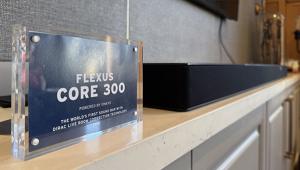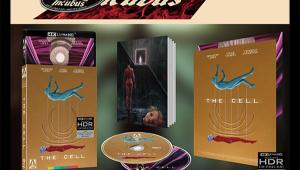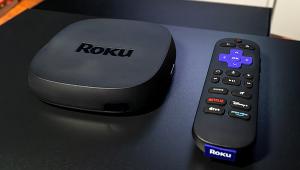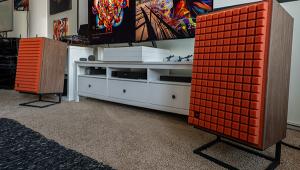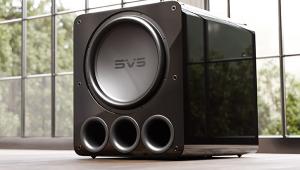NuVision Lucidium NVU55FX10LS 3D LCD HDTV Page 3
3D Performance
As of January 2011, the NuVision’s 3D is compromised in two ways. First, there’s no 2D-to-3D conversion, although NuVision’s Website clearly states otherwise (at least it does as I write this). That’s not a huge deal; these conversion modes aren’t all that great in general. Besides, a number of new Blu-ray 3D players are becoming available that have this feature built in. Of course, these players will only help with discs and not with broadcasts, which could be a drawback if you’re planning a SpongeBob 3D festival for family and friends.
Far more significant is the fact that the NVU55FX10LS doesn’t currently do full-resolution 3D. As of press time in mid-January, the set only supports side-by-side or top-and-bottom 3D, lower-resolution 3D formats developed primarily for bandwidth-limited broadcasting over cable and satellite. Side-by-side reduces Blu-ray 3D’s 1920-by-1080 resolution to 960 by 1080 at each eye; top-and-bottom offers 1920 by 540. That’s why NuVision includes a Panasonic Blu-ray 3D player with each NVU55FX10LS; the Panasonic players are the only ones we know of that can convert the full HD present on Blu-ray Discs to either of these other formats.
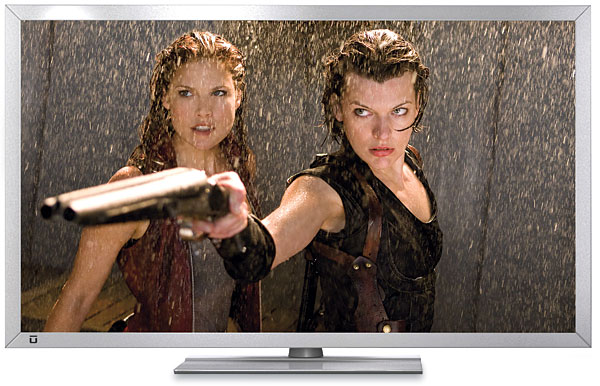
NuVision told us that by the second quarter of 2011, or shortly after you read this review, it would modify its FX10LS production to display full-resolution 3D. But this will require a hardware change, so don’t count on an upgrade to an early production NVU55FX10LS. To ensure that the change has been made before you write the check, set the Panasonic player to Full HD and pop in a 3D disc. If you see a garbled picture instead of a crisp 3D image (with the 3D glasses on, of course) and no setting in the NVU55FX10LS’ 3D menu will fix it, the change to the set has not yet been made—at least not in that sample. At this price, you should expect the best Blu-ray 3D performance possible—and on Blu-ray, that means a full 1920-by-1080 resolution at each eye.
Although the NuVision doesn’t offer separate 2D and 3D menus, I only made two small changes to the settings when I switched to 3D. I increased the Gamma setting to 2.2 and the Sharpness to 50. The increase in sharpness helped compensate for the loss of resolution in the side-by-side mode, and the Gamma change helped compensate for slightly washed-out 3D images in the 2D settings.
When you call up the NuVision’s menus while you watch 3D, the side-by-side menus will be usable but tricky to read. You must set the 3D control manually with each different 3D disc; there’s no Auto 3D mode. Both the Backlight control and the True Dimming feature are disabled in 3D; they remain adjustable, but altering the adjustments has no effect on the picture.
Those caveats aside, the NuVision’s 3D performance was far more impressive than I expected, given the absence of full-resolution HD 3D. A subtle loss of detail is evident if you look for it closely, particularly if you’ve seen the same sources on a full HD 3D set. But the picture was still arguably high definition in a subjective sense, even if technically it was not. The 3D effect was palpable, and it held up well even at reasonable off-axis angles. When I tilted my head, the NuVision’s picture simply became progressively darker. Ghosting was no more frequent than it is on other good 3D LCD sets. It was more common than on a 3D plasma set, but it was still rare enough to be unobtrusive. NuVision’s 3D glasses were also relatively comfortable.
While the NuVision’s 3D picture was dim in the usual 3D fashion, it was rarely too dim. Your eyes adjust relatively easily to reduced image brightness (they’ll do so more effectively if you also darken the room). For the most part, the 3D sources I watched looked outstanding. Avatar on 3D offered some of the most striking 3D images I’ve yet seen, either at home or in the theater. Sorry for the tease (this film is currently available to the public in 3D only as an exclusive for Panasonic buyers), but this title dramatically shows how impressive 3D at home can be that I had to mention it.
The sole exceptions to the NuVision’s fine 3D performance were on dark program material. The many murky scenes in A Christmas Carol were even murkier than usual on the NVU55FX10LS. The uneven illumination around the screen’s edges was even more distracting, particularly at the bottom of the screen where two pesky gnomes with flashlights appeared to be hiding just below the frame.
Conclusions
I watched the NuVision for close to 100 hours, and I rarely felt the urge to switch to another display. There’s a good set in here waiting to get out. With its striking ultra-slim styling, good color, and great 2D resolution, the NuVision NVU55FX10LS has a lot going for it.
But at this price, I expect state-of-the-art black level performance, uniform screen illumination, and full HD 3D resolution. The latter appears to be coming later in the year, but the other issues may be tougher nuts to crack. As a reference display, the NVU55FX10LS isn’t quite there—yet.
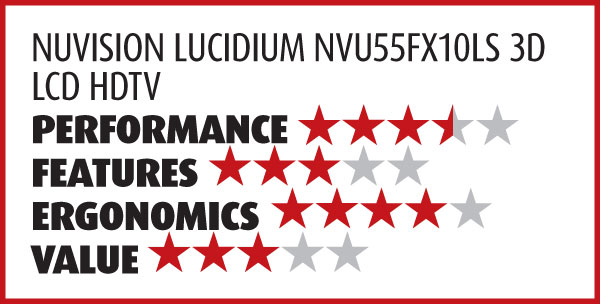
- Log in or register to post comments












